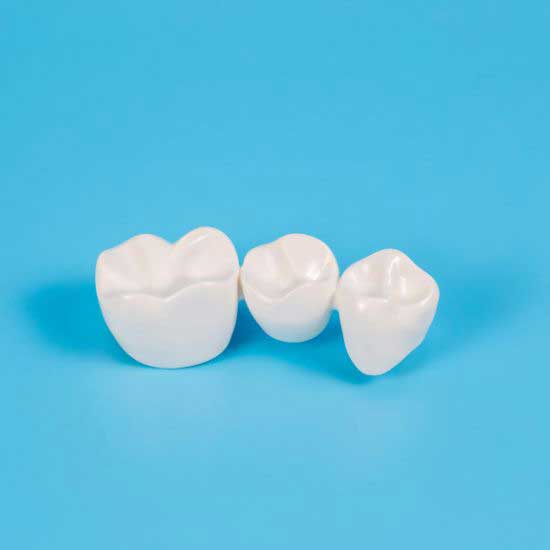Dental Crowns and Bridges
Repair damaged or
missing teeth.
Dental crowns and bridges are two common dental procedures that are used to repair and replace damaged or missing teeth. Both of these treatments involve the use of a prosthetic device that is placed over or attached to existing teeth or dental implants.

What are Dental Crowns?
A dental crown is a prosthetic device that is designed to cover and protect a damaged or decayed tooth. Crowns are typically made from materials such as porcelain, ceramic, or metal alloys, and are custom-made to fit over the tooth that needs to be repaired. Crowns can also be used to improve the appearance of discoloured or misshapen teeth.
Dental crowns are often used when a tooth has suffered significant damage or decay, and a filling is not sufficient to restore its function and appearance. Crowns can also be used to protect a tooth after a root canal procedure or to hold a dental bridge in place.
Dental Crown and Dental Bridges



Dental Crowns: The Procedure
Getting a dental crown typically requires two visits to the dentist. During the first visit, the dentist will prepare the tooth by removing any decay and shaping it to fit the crown. An impression of the tooth will be taken and sent to a dental laboratory where the crown will be fabricated. In the meantime, the dentist will place a temporary crown over the prepared tooth to protect it. Once the permanent crown is ready, the patient will return to the dentist’s office to have it placed over the prepared tooth using dental cement.
What are Dental Bridges?
A dental bridge is a prosthetic device that is used to replace one or more missing teeth. Bridges are typically made up of two or more crowns that are connected together, with the artificial teeth in between. Bridges can be made from a variety of materials, including porcelain, ceramic, and metal alloys.
Dental bridges are used to fill the gaps left by missing teeth, which can affect the appearance of the smile as well as the ability to chew and speak properly. They can also prevent the remaining teeth from shifting out of position and causing further dental problems.
The Procedure for Getting a Dental Bridge
Getting a dental bridge typically requires two or more visits to the dentist. During the first visit, the dentist will prepare the teeth on either side of the gap by removing some of the enamel and shaping them to fit the crowns that will hold the bridge in place.
An impression of the prepared teeth will be taken and sent to a dental laboratory where the bridge will be fabricated. In the meantime, the patient will be fitted with a temporary bridge to protect the prepared teeth and maintain the bite. Once the permanent bridge is ready, the patient will return to the dentist’s office to have it placed and adjusted to ensure a proper fit and bite.
A healthy and beautiful smile
Dental crowns and bridges are two common dental procedures that can help restore the function and appearance of damaged or missing teeth. If you think you may need a dental crown or bridge, consult with your dentist to determine the best treatment option for your needs. With proper care and maintenance, a dental crown or bridge can last for many years, providing you with a healthy and beautiful smile.
FAQ - Frequently Asked Questions
What is a dental crown?
A dental crown is a tooth-shaped cap that is placed over a damaged or decayed tooth to restore its strength, shape, and function.
What is a dental bridge?
A dental bridge is a prosthetic device that is used to replace one or more missing teeth. It is anchored to the adjacent teeth with dental crowns.
What are dental crowns and bridges made of?
Dental crowns and bridges can be made of various materials, including porcelain, ceramic, metal, or a combination of materials.
How long do dental crowns and bridges last?
The lifespan of dental crowns and bridges depends on a variety of factors, including the materials used, the quality of care, and the patient’s oral hygiene habits. With proper care, dental crowns and bridges can last for many years.
Are dental crowns and bridges painful to have placed?
The process of placing dental crowns and bridges typically involves numbing the affected area with a local anesthetic, so patients should not experience pain during the procedure. Some patients may experience some discomfort or sensitivity after the procedure, but this can usually be managed with over-the-counter pain relievers.
How do I care for my dental crown or bridge?
It’s important to maintain good oral hygiene habits, including brushing twice daily and flossing at least once a day. Patients should also avoid chewing on hard foods or objects, and should schedule regular dental checkups and cleanings.
Can dental crowns or bridges be removed?
Dental crowns and bridges are designed to be permanent, but they can be removed if necessary. This typically involves cutting or drilling off the crown or bridge, which can damage the underlying tooth structure. As such, removing a dental crown or bridge is usually a last resort.
We Bulk Bill
We bulk-bill HICAPS, Kids eligible under child dental benefit scheme (CDBS), Veteran Affairs (DVA Gold Card), Emergency and General dental vouchers from QLD Government (Oral Health Services).
- HICAPS - for fast claims on the spot
- Veteran Affairs (DVA Gold Card) bulk billing options available
- Eligible kids are bulk-billed under Child Dental Benefit Scheme
- We accept general dental vouchers from QLD Government








